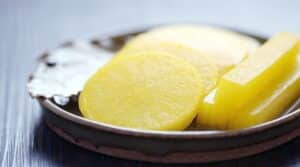Takuan - Pickled Daikon Radish
Takuan – Pickled Daikon Radish

Takuan, very simply, is made by harvesting daikon, hanging it in the sun for a number of weeks, allowing it to dehydrate and soften, as it has a large water content when harvested and is exceptionally firm. Traditionally, after a few weeks of dehydration and softening the leaves are removed and it is placed in a crock and submerged in a brine which is a mixture of salt, rice bran, sugar, daikon leaves, and kombu (a kelp that contributes some “umami” flavor) for several months. This is a process very similar to making other pickled and fermented foods like kimchi and sauerkraut. When removed from the brine, chemical reactions have turned the daikon yellow and it can be quite pungent and sour with a far more complex flavor profile than the raw version, which is exceptionally mild.
The pickled radish, which is now called “takuan,” is then rinsed with water to remove a lot of the brininess (otherwise it’s very salty) and sliced thinly to be eaten as a side dish or a snack. It is often eaten after a meal as it is believed to aid digestion. In our modern era, however, most commercial takuan is made by processing the daikon in a syrupy brine with yellow food coloring, which accelerates the process but also creates a much more mildly flavored product, without the sourness and complexity of the “real thing.” If you can, we suggest trying to find traditionally made takuan. Traditionally made varieties are also used in other cooked dishes, being added to stir-frys and other foods, particularly as it can become more sour over time and add complexity to other dishes.
Interestingly, the creation of this particular food is credited to Takuan Sōhō, a Japanese Buddhist prelate who lived during the Sengoku and early Edo periods of Japan (the late 1500’s to mid 1600’s), hence bearing his name. Would that we were all fortunate enough a have a dish bearing our name.
I have always been fascinated by the creation and culture of different foods, particularly sushi and sashimi in the modern era of Japanese cuisine. I am a classically trained chef and sushi connoisseur, also having operated a food service company and enjoy investigating and experimenting with food around the world.